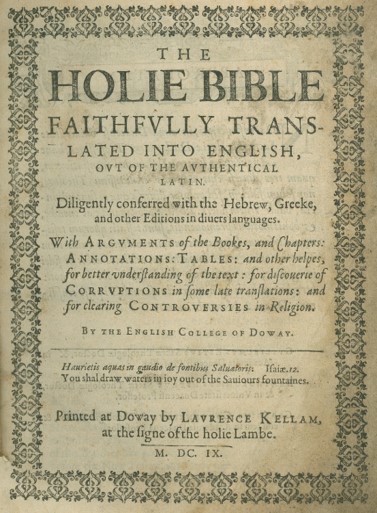
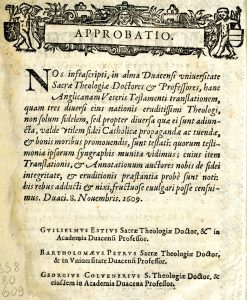




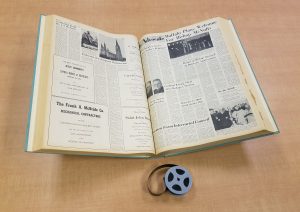
Based on research by Professor Alan Delozier
Selections from the Catholic Advocate, the official newspaper of the Archdiocese of Newark, have now been digitized in a cooperative project between Seton Hall University’s Special Collections and the Catholic Research Resources Alliance (CRRA). The newspaper has been published regularly since 1951; however, the issues selected for this digitization project were limited to the years 1958-1964, the era of the Second Vatican Council, enabling researchers to examine this period and its impact on the Newark Catholic community. The project digitizes newspapers from around the country, enabling scholars to examine differences and similarities between regions during this period.
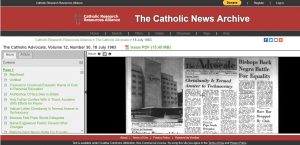
Seton Hall Special Collections and University Library staff selected the best quality images to scan and provided description of the materials to allow for the detailed searches that are now possible. As part of the digitization process, the text was captured using Optical Character Recognition (OCR) to allow for keyword searches of the entire text of each article, not just the titles. If a word or name is mentioned anywhere in an article or even in a photograph caption, it will be found in the powerful search engine used in the portal. However, because the contents were read by machine, interpretive errors are possible in the text. Therefore, the public is invited to read and correct the text, and particularly active commentators are acknowledged on the website in a “Hall of Fame.”
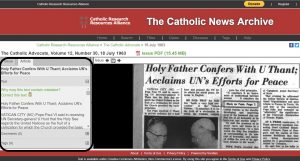
The CRRA has digitized many more newspapers as part of its project, including the San Francisco Archdiocese’s Monitor, the Clarion Herald of New Orleans, and the Catholic Telegraph of Cincinnati, among others. The project and the construction of the Catholic News Archive website was the recipient of a Catholic Communications Campaign grant from the United States Conference of Catholic Bishops.
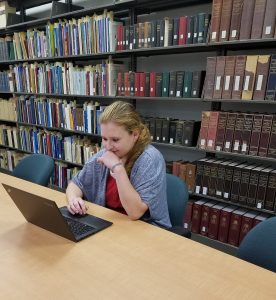
The digitized materials are currently being utilized in classes at Seton Hall University. Professor Alan Delozier, University Archivist, has introduced students to this new resource in his class “New Jersey Catholic Experience,” offered through the Department of Catholic Studies. Students are able to use this powerful new tool to conduct in-depth research on the history of the Catholic New Jersey community.
The new portal and all of its content can be explored here; the Catholic Advocate content specifically be found here.
Written by Rev. Michael Barone
The Spring 2018 semester at Seton Hall University found Archives staff at the Monsignor William Noé Field Archives and Special Collections Center beginning to process the collection belonging to the eponymous former University Archivist, Director of Special Collections, and Rare Book Librarian, who died in December 2000.
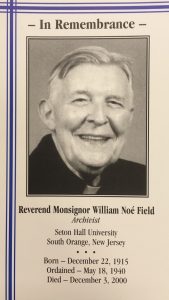
Speaking to people who knew him, one learns that “Father Field” was a fixture on campus and in the Archdiocese of Newark, for which he was ordained a priest in 1940.
While the arrangement and description of the collection is still an ongoing project, looking through Monsignor’s papers and ephemera, one sees the story of a priest, scholar, lecturer, and traveler beginning to take shape. After all, archivists process and maintain the collections of persons so that their lives and work might be preserved for future generations of researchers and historians. While tedious at times, the task of archiving invites oneself to experience a sense of reverence or respect for the subject and creator.
Being himself an archivist for 30 years, Msgr. Field’s papers gives insight into the work of a Dean of Library and Special Collections Director, who earned his MLS from Columbia University in 1961.

Most of the collection is structured to organize his academic papers. However, Monsignor Field was also a gifted poet who sent and received numerous greeting cards from all across the globe. These are part of a correspondence series. Msgr. Field kept detailed travel logs, postcards, and brochures from years of travel. Beloved chaplain and member of several professional societies, the numerous awards, religious and devotional objects, owned and collected by the priest, will be discoverable by use of a detailed finding aid describing its inventory of materials and their structure.
Entering the reading room, one notices a prominently placed bust and portrait of Msgr. William Noé Field, welcoming visitors to his beloved
Archives, which bear his name. Founded during his lifetime, and organized with help of Peter Wosh, the Center remains a valuable repository and resource. For more information, or to schedule a visit to the Archives at Seton Hall University, located on the ground floor of our Walsh Library. We look forward to this collection being available to the public in the very near future.
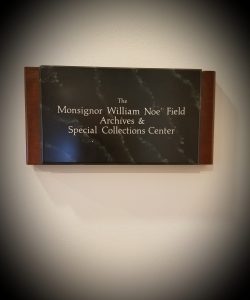
Based on research by Professor Alan Delozier (Book of Kells) and Sarah Ponichtera (Gradual)
The Seton Hall University Archives & Special Collections Center is currently exhibiting two recently acquired high quality facsimile volumes of the original Book of Kells and The Gradual of St. Katherinenthal donated to our institution through the generosity of Mr. Peter Graham. These works each have a distinguished history both in terms of literary content and aesthetic value which allows our community the opportunity to view and study copies of these editions in close detail.

Book of Kells (Fine Art Facsimile Volume). Fox, Peter, (Faksimile-Verlag, Trinity College (Dublin, Ireland) Library, Dublin and Lucerne: 1990) [Latin: Codex Cenannensis. Irish: LEABHAR CHEANANNAIS] ]
According to scholars, this work was created around the year c. 800 AD and produced through the artistry of a triad of unidentified Columban Monks. The Book of Kells is most famous for its ornate illustrations. Abstract designs and images of plants, animals and Biblical figures not only serve the purpose of glorifying Jesus’ life and message, but also constitute a rich symbolic system in themselves. Symbols of the evangelists Matthew (the Man), Mark (the Lion), Luke (the Calf) and John (the Eagle) adorn related sections of the text; in addition, there are full depictions of the Virgin and Child; a portrait of Christ, and complex narrative scenes, which were the earliest to survive in gospel manuscripts, representing the arrest of Christ and his temptation by the Devil. The text grew increasingly well known throughout the nineteenth century. It is thought of as one of the central artistic works of Celtic culture, and a source of national pride for Ireland.
The text proper includes the Gospels of Matthew, Mark, Luke, and John from the Vulgate (Latin translation) version of the Bible as translated by St. Jerome, and also contains texts from an earlier Old Latin translation featuring more specialized religious texts. It was only brought to the altar a few times per year and only during important liturgical events within the Church, especially the Easter Vigil. The book remained in Kells until 1654 when the original was moved to protect it from the invading armies of Oliver Cromwell and transferred to Dublin and the Library at Trinity College where it remains on display to this day and seen by upwards of half a million visitors per year on average. This facsimile edition was produced with scrupulous attention to detail, hand-sewn, and compared against the original by an expert at Trinity College, Dublin. At present, approximately 81 other libraries across the globe own a copy. The original has been completely digitized by Trinity College and made available to the public free of charge.
Gradual of St. Katherinenthal, Upper Rhine, 1312. (Fine Art Facsimile Volume No. 729). Duft, Johannes, (Faksimile-Verlag, Luzern: 1980).
The Gradual of St. Katherinenthal is a collection of church hymns, which were recited by the Gregorian choir during mass in the 14th century. The sheet music is embellished with brightly colored pictures backed with the finest gold leaf. The work is widely regarded as the finest example of Gothic book art in the world. The unusual size is meant to allow all the singers of the choir, even those standing further away, to easily read the pages. The book opens with two pages that contain calendric information. The following pages contain musical scores in the Gregorian four line system, that each incorporate staves and lines of text. The book includes 71 elaborately designed miniatures with gold decoration, 13 flowers painted to form letters, and a considerable amount of calligraphy. The origin of the gradual from the St. Katherinenthal monastery and its time of creation, circa 1312, is recorded in handwriting on the inside of the front cover. At least six artists were involved in the creation of the work, but their names were not recorded here. The St. Katherinenthal Abbey was a monastery of Dominican nuns located near Lake Constance, Switzerland, and represented one of the oldest communities of nuns in that part of the world. The original Abbey, along with the town, was burned to the ground in 1388, but was rebuilt in the beginning of the fifteenth century. The community was exceptionally well-documented for that time period, and we have personal stories of many of the nuns recorded in the “Sister Book” of the Abbey.
This is one of the stories written by the nuns who would have sung the songs in The Gradual of St. Katherinenthal. This book, written in Medieval High German, is being translated by Amiri Ayanna, a project for which she won the PEN translation award in 2011. These stories give a window into the world of the nuns of that day. Today the Abbey continues to operate in what is now the town of Weesen, and runs a bakery that produces Eucharistic breads, as well as a guesthouse.
The exhibit also features a 3D printed Gothic cathedral, to give a richer sense of the aesthetic that produced the gradual. The cathedral was printed at Space 154.
For more on rare books at Seton Hall, see our LibGuide.
May Day is observed in various celebratory ways and this is no different within the Catholic Church as this diurnal it is a starting point for month-long devotions to the Blessed Virgin Mary across the globe. Counted among the most evident displays of homage include the annual “May Crowning” of Mary statues found within churches worldwide, creation of art works depicting the image of the Holy Mother, increased prayers, group recitations, and other means homage that invoke and honor her name and example. This increase in commitment to Mary has been nurtured over time especially from the 18th century forward. Within the Pre-Vatican II era, the official pronouncement of the “Queenship of Mary” and her connections to May as a time of greater ceremony came in the Marian Year of 1954 when Pope Pius XII (1876-1958) made in his encyclical – Ad Caeli Reginam. This inspired an oft-recited hymn that reads – “Hail Virgin, dearest Mary! Our lovely Queen of May! . . . ”
Mary herself was a Nazarean who lived in the 1st century BC and is known according to New Testament texts as the mother Jesus Christ by way of conceiving miraculously through the Holy Spirit. The Mother of God was assumed into Heaven after her mortal life ended and her example has led to several assertions that she has appeared in miraculous fashion to different followers over the years. This has led to Mary being the most venerated and admirable of all saints to most within the Catholic Church.
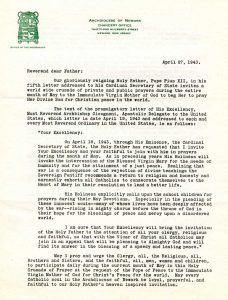
The example of Mary served the faithful not only in times of peace, but especially in times of turmoil. A decade before the “Queenship of Mary” was formally established, and as the Second World War raged, Vatican Secretary of State Cardinal Amleto Giovanni Cicognani (1883-1973) reached out to the American hierarchy on behalf of Pius XII to encourage focused prayer during the month of May. In particular, he made special note of all to call on the intercession of the Blessed Virgin Mary in helping all people to lead a true life and to always remember – “. . . the needs of humanity and for the attainment of a just peace . . . at this time of conflict across the world.” In response to this request, Archbishop Thomas J. Walsh (1873-1952) asked the faithful of the Archdiocese of Newark to not only participate in daily contemplation, but engage in the Holy Crusade of Peace as a means of honoring the Solidarity of Mary. This was a means of joining the call of the Vatican in other shows of spiritual commitment on a daily basis as outlined in the April 27, 1943 circular letter illustrated on this page.

Archbishop Walsh also expressed the wish that the Litany of the Blessed Virgin, Litany of Loreto (a special Marian-centered prayer first uttered in 1587), and the “Prayer for Peace” (found below) each be read after each Mass throughout the month of May.
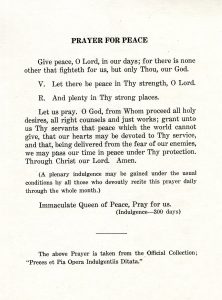
In addition, further demonstrations of faith included public services that featured the recitation of the Rosary of the Blessed Virgin Mary and honoring the Mother of Christ with a Benediction of the Most Blessed Sacrament at each parish and mission chapel throughout the Archdiocese of Newark. Additionally, in accordance with the hope that the Catholic youth of the Newark See would be more active in spiritual exercises of this type, it was requested by Archbishop Walsh that students make a devotion to their nearest church every school day in addition to worship on Sundays.
This circular was read to parishioners at each parish throughout the Archdiocese of Newark during Masses conducted on Sunday, May 2, 1943. In looking back 75 years later, this devotion to Mary shows how the words of the hierarchy and enlistment of the faithful helped in making peace a reality and further strengthened belief in the Blessed Virgin and her example through continued dedication throughout the month of May and even beyond.
For more information on Marian traditions, Archdiocese of Newark history, and other research subjects please feel free to contact at: Alan.Delozier@shu.edu / (973) 275-2378.
This exhibit on display throughout the Spring 2018 semester on the first floor of Walsh Library is designed to share the historical significance of remembering the Holocaust and have furthered the discussion of inter-religious dialogue and cooperation over the last century into the new millennium. This select array of materials on display also provides an introductory and research-oriented means of appreciating the power of individual and communal stories through the sharing of documentary evidence.
The Jeifa Family Collection is based mainly on the contributions of Mr. Michel Jeifa (b. 1927) who was born and raised Paris, France and surviving the Holocaust and being able to endure after the deaths of his parents in concentration camps during World War II. Various representations of life before and after this tragedy along with symbols and pride in their faith have been preserved by Michel, his children, and grandchildren as part of an important and lasting legacy.
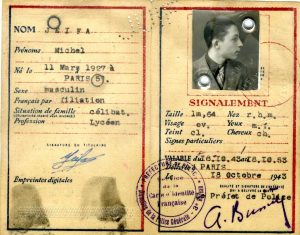
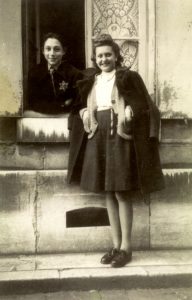
Founded in 1953, The Institute of Judaeo-Christian Studies became a trailblazing enterprise devoted to religious dialogue and understanding. The first director was Monsignor John Oesterreicher and through his vision and that of former university president, Monsignor John L. McNulty, Bishop John J. Dougherty, and others. More detailed and additional information on Judaeo-Christian Studies and related initiatives sponsored through this Center can be found on the Institute homepage at: https://www.shu.edu/judaeo-christian-studies/

The materials presented here were selected from various portions of the Archives & Special Collections Center at Seton Hall University with editorial assistance from Reverend Lawrence Frizzell, Director and Associate Professor of the Jewish-Christian Studies Graduate Program, and Ms. Gisele Joachim, Dean of Enrollment Management of the Seton Hall University School of Law.
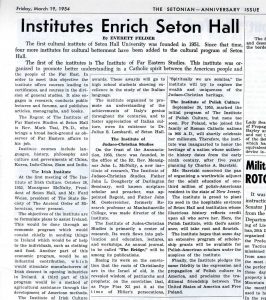
For more information on this exhibit and other materials related to the Holocaust and Judaeo-Christian Studies, please contact Alan Delozier, University Archivist via e-mail at:<Alan.Delozier@shu.edu> or phone: (973) 275-2378.

We are pleased to announce a new exhibit in honor of the late Governor Brendan T. Byrne which is being hosted by the Archives & Special Collections Center through the Spring 2018 semester.
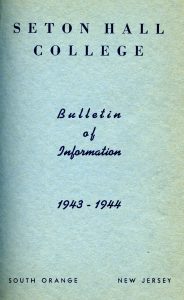
Brendan Thomas Byrne was born April 1, 1924 in West Orange, New Jersey, the fourth of five children born to Francis A. Byrne and Genevieve (Brennan) Byrne. He attended Seton Hall College in 1943 before leaving to enroll in the United States Army Air Corps as a navigator during World War II. Byrne earned a Distinguished Flying Cross, three Air Medals, and a Presidential Unit Citation before his honorable discharge from the service in 1945. Upon returning from overseas, Byrne graduated from Princeton University in 1949 and received his LL.B. from Harvard Law School two years later. The future governor first worked as a clerk for future Chief Justice of the New Jersey Supreme Court, Joseph Weintraub and assisted attorney John W. McGeehan of Newark during the early 1950s.

The public career of Byrne began in the early 1950s as a member of the West Orange Planning Board. He then earned appointed as Assistant Council within the administration to Governor Robert B. Meyner in 1955. Byrne was later promoted to the position of Executive Secretary the following year, and held this post until 1959. Later that year, Byrne was named Deputy Attorney General in charge of the Office of the Prosecutor for Essex County 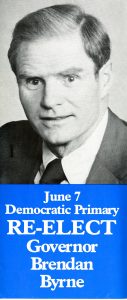 and within months he was made the Essex County Prosecutor. Over the next decade, Byrne argued over 60 different cases before the New Jersey Supreme Court and achieved recognition for prosecuting dishonest contractors and powerful underworld figures. Starting in 1968, Byrne served as President of the State Board of Public Utility Commissioners. He left this position when he was appointed to the New Jersey State Supreme Court in 1970. In 1971, he handed down a decision that declared the state law on capital punishment unconstitutional. He resigned from the Supreme Court in 1973 to run for Governor.
and within months he was made the Essex County Prosecutor. Over the next decade, Byrne argued over 60 different cases before the New Jersey Supreme Court and achieved recognition for prosecuting dishonest contractors and powerful underworld figures. Starting in 1968, Byrne served as President of the State Board of Public Utility Commissioners. He left this position when he was appointed to the New Jersey State Supreme Court in 1970. In 1971, he handed down a decision that declared the state law on capital punishment unconstitutional. He resigned from the Supreme Court in 1973 to run for Governor.
The platform chosen by Byrne in the gubernatorial election of 1973 was based on the slogan “one honest man can make a difference.” Between the years of 1970 and 1973, several New Jersey public officials were indicted by federal grand juries, and with Watergate still in the news, Byrne ran on a platform of restoring public confidence in the government. His opponent was Republican candidate Charles Sandman, who criticized Byrne throughout the campaign for his reluctance to publicly state his position on controversial issues, but instead preferred to issue position papers. On November 6, 1973, Byrne won by over 721,000 votes.
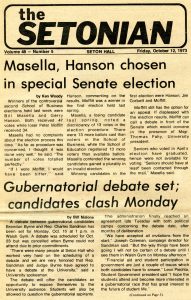
Nicknamed “One Term Byrne” by critics, he surprised political experts in 1977 when he won re-election against Republican candidate Raymond H. Bateman. Despite being considered the underdog in the race, Byrne won by a large majority. During his two terms time as governor, he created a legacy that includes the Meadowlands Sports Complex, development of Casinos in Atlantic City, dedication to the environment exemplified in the Pinelands Preservation Act, and a commitment to improving public education.
After stepping down as governor in 1982, Byrne returned to the private sector as an attorney, co-wrote a column in the Newark Star-Ledger with his gubernatorial successor Thomas Kean, and taught classes at various colleges prior to his death on January 5, 2018.
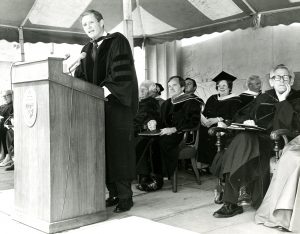
This exhibit (which will run throughout the Spring of 2018 and viewable at the Archives & Special Collections Center, located on the First Floor of Walsh Library) shows the ties Byrne had to Seton Hall as a student prior to the call to service in World War II. In addition, included are his debate stop during his first gubernatorial campaign, honorary degree ceremony (1974), and aid with the Meadowlands Development project which bore his name during the 1970s-80s where Seton Hall sponsored a number of events from Men’s Basketball games (held regularly between 1982 until 2007) to Commencement and other activities of note. Additionally, select materials that provide an overview of his campaigns, work among the citizenry of New Jersey, summary of initiatives, and related items that provide a look at the man and his work on behalf of the Garden State and its citizens encompass this display.
More information on the Brendan T. Byrne Collection at Seton Hall University can be accessed via the following site link – http://academic.shu.edu/findingaids/mss0007.html or you can contact Alan Delozier, University Archivist/Education Coordinator by e-mail at: <Alan.Delozier@shu.edu> or phone: (973) 275-2378.

On display during the Fall 2017 semester is an exhibit entitled: “Setonia in Stage & Song – South Orange & New Jersey Perspectives (1856-Present)” that features connections between the artistic legacy of early Seton Hall and how the contributions of students and alumni along with special visitors to campus have made the campus a perpetual home for creative expression. The earliest examples of musical inclination came through the rental of instruments by students during the early 1860s which complimented classroom and public recitations along with a thriving Drama Society that produced programs in honor of different school, church, and national holidays. Counted among the most prolific individual actors of the late nineteenth and early-mid twentieth century who attended Seton Hall include John Barrymore (1882-1942) who was accepted by most critics as the foremost English-speaking actor of his time for his mastery of Hamlet and Richard III among other Shakespearean works, and Lionel Barrymore (1878-1954) known for his motion picture roles most notably in Dr. Kildare and It’s A Wonderful Life. A contemporary of theirs was Albert “Raoul” Walsh (1887-1980) who came to South Orange in the 1900s, a famed director known for his work on High Sierra and White Heat among others.
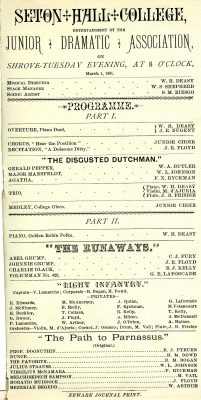
From the turn of the century onward, Seton Hall was home to further dramatic productions with heavy patronage and perpetual interest. Those who belonged to student organizations often collaborated with local Catholic colleges for joint performances, campus visits, radio broadcasts (local radio stations, and over national networks – Mutual and CBS), but also the Seton Hall Orchestra, the Schola Cantorum (Choral Group that sing the Gregorian Chant and Polyphony for High Mass), and Glee Club under the direction of noted musicologist and Head of the Department of Music – Nicola A. Montani, K.C. St. G.) were in demand for events including the signing of signature school songs namely – “The Alma Mater” and “March Setonia” along with others at the “Annual Concert” in Newark and other venues throughout the East Coast. From the late 1940s onward, campus radio station W-S-O-U (the first college-operated FM outlet to hit the air in New Jersey) offered listeners radio dramas and also played host to such noted entertainers as Vaughn Monroe and Connie Francis (from nearby Newark) along with regularly scheduled live musical programs. This ranged the gamut from early vinyl (and later CD) from classical and opera to religious to their current heavy metal format, many artists have been played on campus airwaves and keep the appeal of music alive.
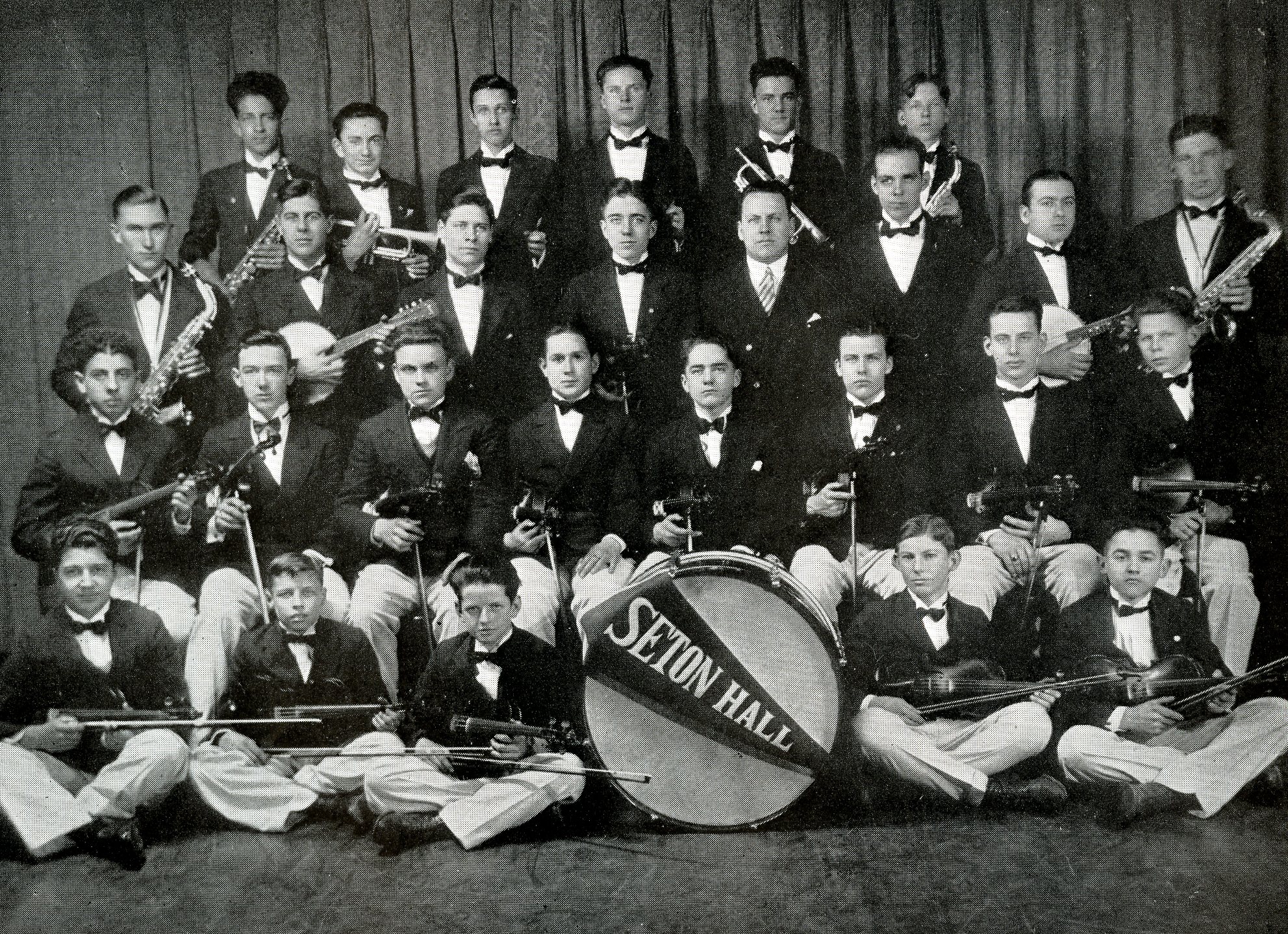
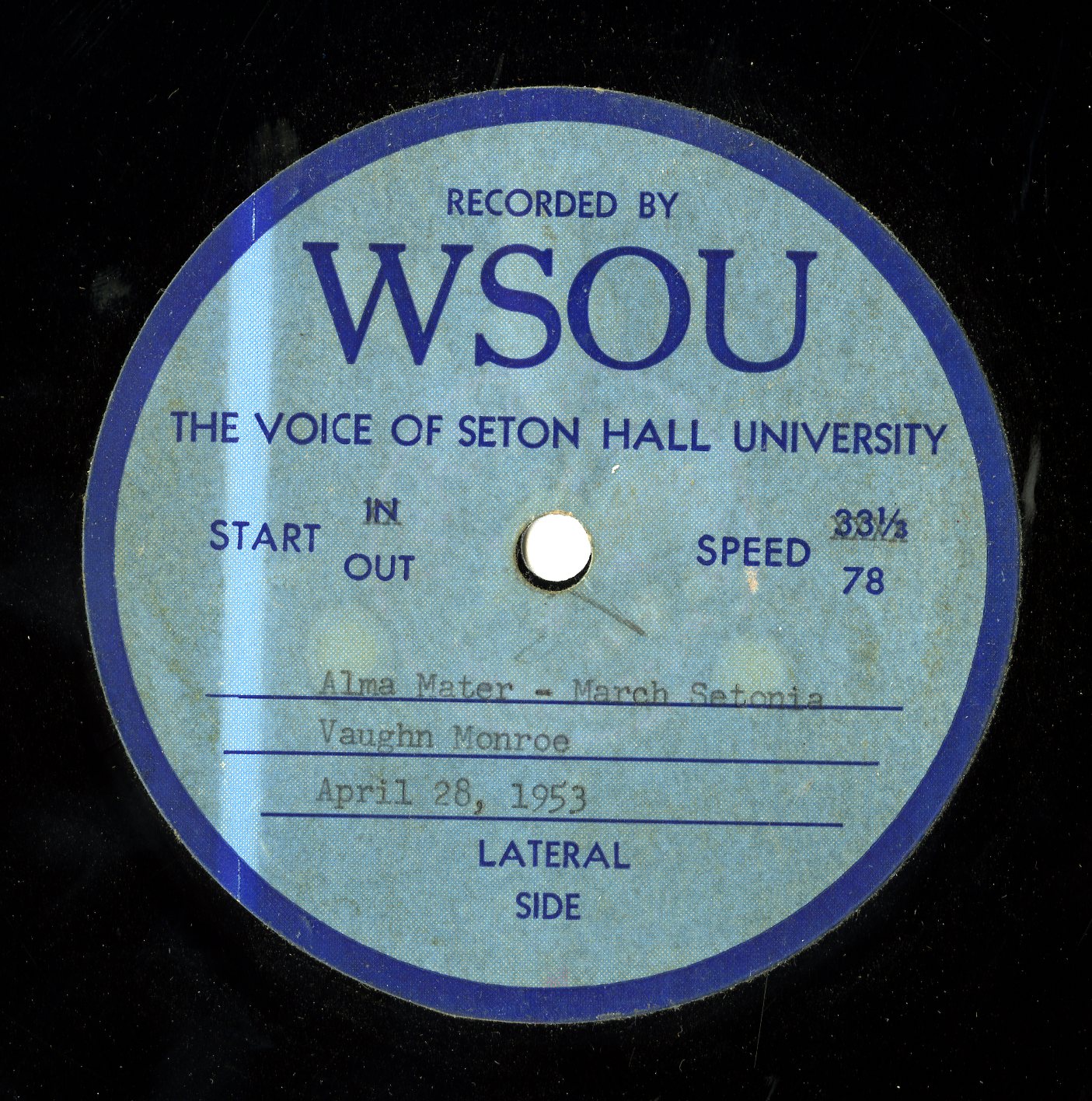
Over the last half century, Seton Hall has produced a number of individuals who have been active in the entertainment business including actors Ron Carey (’56) (Barney Miller), Kevin “Chuck” Connors (The Rifleman and Old Yeller), Josephine Siao (Hong Kong actress), and producer E. Duke Vincent (’54) (Beverly Hills 90210 and Melrose Place). Many others have a connection to the school, but also those who visited our site for special concerts or recitations are legendary. A number of locally famous individuals including Bruce Springsteen (and the E-Street Band drummer Max Weinberg, a Seton Hall student) (Freehold), Frankie Valli and the Four Seasons (Newark), Dionne Warwick (East Orange) and many others who graced our stages across campus over the last several decades.

Traditions have endured and adapted with the times with the Drama Society becoming known more widely as the “Theater-in-the-Round” with performances held in the Dougherty Student Center and as of the 2000s at the South Orange Performing Arts Center. Other groups including the Gospel Choir, Coffee House Concerts, Celtic Theater, and the Pep Band among others have kept alive traditions and brought new ones to campus to celebrate the creativity of our student population. Like those early Setonians of the 1860s who were interested in music and expression, over the years the school has maintained a coursework in the applied arts (now known as Communication and the Arts) for those with an academic interest in the field. Further concerts, productions, and related
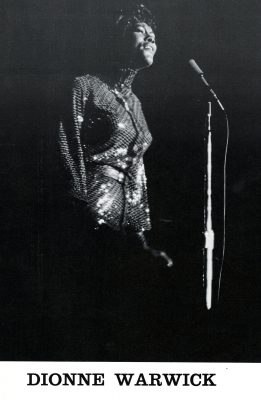
contributions remain strong for the Setonia community to explore and share as we move forward into the 2017-18 semester and beyond.
This exhibit can be viewed on the first floor of Walsh Library (across from the stairway) through the Fall 2017 semester. For more information about this and related school history please feel free to contact Alan Delozier, University Archivist by phone: (973) 275-2378, or via e-mail: <Alan.Delozier@shu.edu>
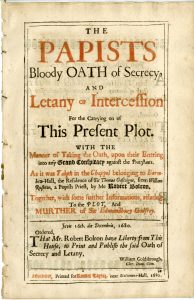
A new exhibit in the Msgr. William Noé Field Archives & Special Collections Center Reading Room highlights materials from our Anti-Catholic Ephemera collection. This small collection dates from 1765-1952. It contains several pamphlets expressing anti-Catholic sentiment and denouncing Catholicism. Although they are not displayed in this exhibit, the collection also includes some materials relating to the Philadelphia Nativist Riots, in which Protestant nativist groups lashed out against Irish Catholic immigrants and burned several Catholic churches. In addition to materials from the Anti-Catholic Ephemera collection, several of the items in the exhibit are from our Rare Books collection.
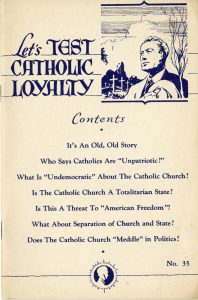
Anti-Catholicism grew out of the Protestant Reformation in the 16th century, and continues in some forms today. It was most common in countries that were majority-Protestant, such as Great Britain and the United States, and sometimes led to discrimination and violence. Catholics were often derogatorily referred to as “papists” or “Romanists,” and were suspected of remaining loyal to the Vatican rather than their countries. Anti-Catholic sentiment overlapped with movements such as nativism when majority-Protestant countries experienced an influx of Catholic immigrants.
Some of the items featured in this exhibit include “Let’s Test Catholic Loyalty,” a 1952 pamphlet produced by the Knights of Columbus as a response to Anti-Catholicism; Popish idolatry; a discourse delivered in the Chapel of Harvard-College in Cambridge, New-England by Jonathan Mayhew, 1765; and The papists bloody oath of secrecy, and letany of intercession for the carrying on of this present plot by Robert Bolron, printed in London in 1680. This document relates to the “Popish plot” and murder of Sir Edmund Berry Godfrey, an English magistrate whose mysterious death stirred up Anti-Catholic turmoil in England.
For more information about the exhibit or the Anti-Catholic Ephemera collection, stop by the Archives or contact us at archives@shu.edu or (973)761-9476.
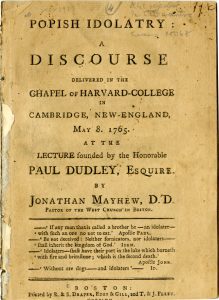



When it comes to understanding print culture and erudition potential in seventeenth century Ireland this era provided an early look at how published communication would take on deeper and more wide-spread significance over time As scholar Raymond Gillespie noted in his work – Reading Ireland : Print, Reading and Social Change in Early Modern Ireland (Manchester University Press, 2005) he wrote that the early-mid 1600s was a burgeoning and “revolutionary” time in the Irish publishing industry which fit natural learning objectives and needs. In other words . . .
“The conditions of print for instance, instructed their followers how to read the Bible, and lawyers and politicians thought they knew how statutes could best be read. These social, political, economic, institutional and cultural frames which surrounded both reading and printing provide a point of departure in understanding the world of print in early modern Ireland.”
Gillespie went on to note that this was an era when the oral tradition was giving way to a growing print culture. In addition, those of the middle and upper class typically viewed manuscripts as “sources of authority” when it came to the recording and transferal of information as found on the printed page. The status symbol of collecting books was rated high among those who had the means to purchase and preserve them. Gillespie went on to add that . . .
“Books by their ability to spread ideas, in conjunction with manuscripts and the spoken word, could be either socially cohesive or disruptive. They also had another more tangible social attribute since the book as object also had the power to carry a wide range of messages. The collecting of books for display in private libraries, for example, was seen as an indicator of social status. A large library, whether read or not, could act as a sign of learning, or pretention to learning.”
With this context in mind, latter day scribes, publishers, and book collectors have provided the foundation for libraries and related information centers to promote educational support on various levels including that of our Irish texts holdings at Seton Hall University.
Since the early 1950s, the library of noted writer and bibliophile Meagher Joseph (M.J.) MacManus (1888-1951) have been housed on the campus of Seton Hall University. The diversity of the titles collected during his lifetime numbered in the thousands and have been the core of a consolidated Irish-centered collection that actively serves our research community to this day. The vision of MacManus went back centuries and covers a wide-range of subject areas with a particular emphasis on history, biography, political science, and religion among other themes that make up the Irish experience. There were also no limits imposed on how old the books had to be when it came to building his substantial library. With this in mind, the lasting legacy of his bibliography contains volumes dating to the 1600s and leading up to his untimely death during the early 1950s.
Among the three oldest surviving volumes found in our combined Irish collections are ones found in English, French, Latin, and/or Irish with each constituting their own story within a story based on the content and what the seventeenth century reader learned and what remains by way of reference text for the reader of these works. Included are the following examples . . .
Le primer report des cases & matters en ley resolue & adiudge en les Courts del Roy en Ireland [1604-1612], by Sir John Davies and Ireland, Courts, 1st ed. (Dublin: Iohn Franckton, 1615)
This work was a French language publication and translates to – “A report of cases and matters in law: resolved and adjudged in the King’s Courts in Ireland [1604-1612]” in the English and is a legal review and digest-oriented volume. The monarch who ruled over Ireland during this time period was James I (1566-1625) who reigned over Éire from 1603 until his death two decades later and held jurisdiction over the isle during the time this work came to light. This text was also one of the earliest legal reference works of any type found in our holdings catalog.
Analecta sacra, nova et mira de rebus catholicorvm in Hibernia pro fide & religione gestis, diuisa in tres partes, quarum I continet semestrem grauaminum relationem, secunda hac editone nouis adauctam additamentis & notis illustratam, Il paraenesin ad martyres designatos, III processum martyrialem quoru(n)dam fidei pugilum, by David Rothe (Coloniae, apud Stephanum Rolinum, 1617) [581 pp.]
An early Latin text related to Ireland when translated into English reads – “(Analecta sacra) and for the faith of the new religion in Ireland, and, the marvelous tales of the deeds of the things Catholic, divided into three parts, one of which contains the six months old burdens the relations of 1. the second edition of this new (adauctam) additions in terms of (notis) illustrate, 2. (paraenesin) to the elect, and the martyrs, 3. the process of martyrialem (Quorum dam) of champions.” Among those named in the text are Dermod O’Hurley and Richard Creagh, Archbishops of Cashel and Armagh and Primate of Ireland respectively who exercised spiritual guidance to their congregations during the early-mid seventeenth century and provides the researcher with a review of early Irish ecclesiastical history.
Tiomna Nuadh ar dTighearna agus ar Slanuigheora Iósa Criosd: ar na ṫarrv₁ng go firn̄eac̓ as Greigis go Giodeilg, by William Daniel and Andrew Sall; Robert Boyle, ed.; Huilliam O’Domhnuill, trans. 1st ed. (A Lunnduin: Ar na c̓ur a geló rē Robert Ebheringṫam, an blíaḋain dc̳óis an Tiġęrna, 1681) [364 pps.]
This tome when loosely translated into the English centers upon the “New Testament and Our Jesus Christ” as its central theme. The book proper was financed by a gentleman by the name of Robert Boyle (1627-1691) who also served as editor of the work. The rarity of Irish language works within our collection (and beyond) was based on limited economic opportunities, total number of Irish readers, and problems with surplus storage among others factors that faced those who had no access to these specialized writings. However, certain texts such as these were connected to religious reference and in the vernacular of the citizenry at large.
Within the broader context of Irish history, these books were published a few decades after the Nine Years’ War of 1594 and the flight of Hugh O’Neil and Red Hugh O’Donnell against Elizabeth I in Ulster, establishment of the Plantation of Ulster by Scottish Presbyterians in 1607 and a prelude to the Irish Rebellion of 1641. From here further works were produced that highlighted circle of life in Éire representative of the leaders, religious, and others who contributed to its historical development overall.
For more information and questions about these and other books in our library please consult our Irish Studies Research Guide for more information and details and/or contact Alan Delozier, University Archivist via e-mail at – Alan.Delozier@shu.edu